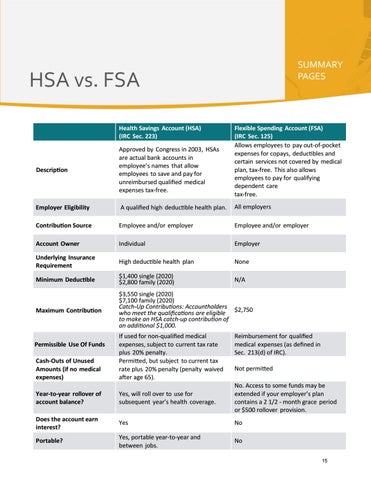SUMMARY PAGES
HSA vs. FSA Health Savings Account (HSA) (IRC Sec. 223)
Flexible Spending Account (FSA) (IRC Sec. 125) Allows employees to pay out-of-pocket expenses for copays, deductibles and certain services not covered by medical plan, tax-free. This also allows employees to pay for qualifying dependent care tax-free.
Description
Approved by Congress in 2003, HSAs are actual bank accounts in employee’s names that allow employees to save and pay for unreimbursed qualified medical expenses tax-free.
Employer Eligibility
A qualified high deductible health plan.
All employers
Contribution Source
Employee and/or employer
Employee and/or employer
Account Owner
Individual
Employer
Underlying Insurance Requirement
High deductible health plan
None
Minimum Deductible
$1,400 single (2020) $2,800 family (2020)
N/A
Maximum Contribution
$3,550 single (2020) $7,100 family (2020) Catch-Up Contributions: Accountholders $2,750 who meet the qualifications are eligible to make an HSA catch-up contribution of an additional $1,000.
Permissible Use Of Funds Cash-Outs of Unused Amounts (if no medical expenses)
If used for non-qualified medical expenses, subject to current tax rate plus 20% penalty. Permitted, but subject to current tax rate plus 20% penalty (penalty waived after age 65).
Reimbursement for qualified medical expenses (as defined in Sec. 213(d) of IRC). Not permitted
Year-to-year rollover of account balance?
Yes, will roll over to use for subsequent year’s health coverage.
No. Access to some funds may be extended if your employer’s plan contains a 2 1/2 - month grace period or $500 rollover provision.
Does the account earn interest?
Yes
No
Portable?
Yes, portable year-to-year and between jobs.
No 15


